Fireworks March Cloud Tour: Yangzhou in Memory
If
Again
I have a chance to meet
There is so much I want to ask
And so much I want to tell about Japanese visual artist Chitano Otsuka
That year, when my friend asked me where I wanted to go for National Day, my longing for Yangzhou suddenly jumped out. The phrase 'Fireworks in Yangzhou in March' deeply resonates with me. That year was the Double Festival of 2009 (National Day and Mid Autumn Festival), and under the bright moon, I still vividly remember the sound of the flute playing on the Twenty Four Bridges of Shouxi Lake. More than ten years have passed in a blink of an eye, and looking back at that city in the most beautiful season.
Shuangdong Historic District
Individual Garden
Dongmen Site
Skinny West Lake
Fuchun Tea House
Sightseeing on the River of Heyuan Ancient Canal
Wenchang Pavilion Yangzhou
Eight Eccentrics Memorial Museum and Double Museum (Yangzhou Museum and China Woodblock Printing Museum)
Yangzhou Formerly known as Guangling, Jiangdu, and Weiyang, this serene small city in central Jiangsu is known for its gentle breeze, drizzle, slanting willows, and moonlight. Compared with ancient Yangzhou, the grandeur of "waist wrapped in a hundred thousand guan, riding a crane down to Yangzhou" has faded away, and the extravagance of "ten years of dreaming of Yangzhou and winning the reputation of a brothel" has also been eliminated. Read through the records of walking through the streets and alleys again to savor this graceful small town.
Shuangdong Historical District: Dongguan Street and Dongquanmen, a charming old district in Yangzhou, where Yangzhou's specialty snacks and old brand shopping shops are gathered on the street.



Individual Garden
In the 23rd year of the Jiaqing reign of the Qing Dynasty (1818 AD), Huang Zhiyun, the general manager of the salt industry in the two Huai regions, expanded the original Ming Dynasty "Shouzhi Garden" into residential gardens, including a northern bamboo viewing area, a central garden, and a southern residential area.
Named after the widespread planting of green bamboo, the character "ge" in the garden name takes half of the bamboo character and represents the various colors of bamboo in the garden.
In addition, the rockery stacking art with the theme of the four seasons features rockeries made of bamboo shoots, lake stones, yellow stones, and Xuan stones, each with its own characteristics in spring, summer, autumn, and winter.
Han School
It is a place for receiving guests. Sinology "refers to the study of Confucian classics by scholars during the Han Dynasty, who placed great emphasis on interpreting texts, examining the system of names and objects, and had a very rigorous academic attitude.
The couplet in the Han School reads: 'If there are books to use, forget about food and drink, cultivate a few new bamboo shoots straight like children and grandchildren.' It means that reading a good book can make people forget to sleep and eat, and planting a few new bamboo shoots looks as pleasing as children and grandchildren. It is said to have been written by Zheng Banqiao, expressing the owner's expectations for their children and grandchildren



Qing Song Hall: 'Qing Song' is' Song of Qing ', which is to sing praises of nobility and promote the virtues of nobility. Among the entire Huang family mansion, the Qing Song Hall holds the highest position, surpassing the buildings on Dong Road Qingmei Hall The Architecture of Hezhong Road Han School The largest in size and highest in specifications, it is the place where the Huang family gathers and receives VIPs, as well as major discussions and ceremonies


The Four Seasons Garden in the center of the individual garden is“
Yiyuxuan
”The garden is spacious with three pillars on the east side and four virtual windows on all sides, providing a panoramic view of the garden. The roof of Xuan is made of common black tiles in Yangzhou, with slightly raised corners, and several pieces of stained glass imported from France during the garden construction are preserved on the east and west walls.
Yiyuxuan is the place where the park owner receives guests
There is a couplet in front of the pavilion: It is advisable to tune the qin in the morning and drum the zither in the evening, and the old rain is suitable until the beginning of the rain





There are various types of bamboo scattered throughout the park, which can be called a bamboo museum.
There are more than 60 types of bamboo in my garden, with nearly 20000 poles and an area of about 12000 square meters. The total area of my garden is less than 24000 square meters, which shows the importance of bamboo in my garden. Bamboo is the soul of a garden.





There is a path in Shushan, and diligence is the way - remember the tour guide said it can lead to the study room









Dongmen Site
Also known as the Shuangwengcheng Site, it is located in the eastern part of the historical district of Dongguan Street. It was first built in the mid Tang Dynasty and has been used by various dynasties to repair city gates and walls.



Daming Temple: Named after its initial construction during the Ming Dynasty of Emperor Xiaowu of the Southern Song Dynasty (457-464 AD)
Qiling Pagoda
As early as the first year of Emperor Wen of Sui's Renshou reign (601 AD), the Qiling Pagoda was built in the Daming Temple. The pagoda is nine stories high and houses Buddha bones inside. It is said that the Buddha is located here. The words of the burning monk Da Jue's spiritual remains, hence the name 'Qiling Pagoda'. Unfortunately, in the third year of Huichang reign of Emperor Wuzong of Tang Dynasty (843 AD), the first generation of scenic spots turned into scorched earth. This is a post destruction reconstruction, which started drilling on August 27, 1993 and officially started construction on December 7.



The "Fifth Spring in the World" was written by Wang Shu, a famous calligrapher and Minister of Personnel during the Qianlong period.
But there are some small stories about this so-called 'fifth spring in the world'.
After being demoted, Ouyang Xiu of the Northern Song Dynasty moved from Chuzhou to Yangzhou and became the governor of Jiangdu. One day, strolling around the Daming Temple, an old monk in the temple invited Ouyang Xiu to come and have tea. After tasting, Ouyang Xiu praised the good tea. The old monk said that this is tea brewed with the spring water in the temple, which is the "fifth spring in the world". Ouyang Xiu became interested upon hearing this and asked, "Which is the fifth spring and what is the basis for it?" The old monk said that this was written by Zhang Youxin, a Tang Dynasty scholar, based on the words of the tea sage Lu Yu. Ling Spring is the first spring in Jinshan Temple in Zhenjiang, Huishan Spring in Wuxi, Huqiu Spring in Suzhou, Guanyin Temple in Danyang County, Daming Temple in Yangzhou, Songjiang River, and Huai River. This is the theory of the Tea Saint, how can it be wrong? "Ouyang Xiu chuckled and asked," Did Lu Yu and Zhang Youxin travel all over the country? At that time, the Central Plains was only a small part of the current world, how can it be called 'the world'? The old monk looked surprised when asked, and upon careful consideration, he no longer claimed to be the "fifth spring in the world" to the outside world. This legend has been passed down to this day, but people still use it to praise the springs of Daming Temple













Xu Yuan
The temple garden was built in 1915 on the site of the former "Taohuawu" to commemorate warlord Xu Baoshan. The gate of the garden is like a full moon gazing at the sun, with the words "Xu Garden" written on the forehead, in regular script and grass, with a unique flavor, written by Ji Lianggong. The main hall in Xuyuan is the "Listening to Orioles Pavilion", which has a pair of carefully carved Nanmu canopy made of high-quality Nanmu wood, extremely delicate

Diaoyutai Cleverly utilizing the technique of "framing scenery" has become a classic work of Chinese garden "framing scenery" art.
Also known as the Wind Platform, it is said that Emperor Qianlong once went fishing here and was named after it. Standing at a certain position on the right side outside the fishing platform, you can see the Wuting Bridge and the White Pagoda from the two circular holes of the fishing platform. Combined with the fishing platform itself, it can be described as a combination of three scenery.



Skinny West Lake
It was named in the early Qing Dynasty, probably because its waterway is curved and narrow, and it is located in the northwest of Yangzhou city, hence it is called "Slender West Lake"


White Tower: Built in imitation of the White Pagoda in Beihai, Beijing, it is said that Emperor Qianlong's visit to Shouxi Lake felt very similar to the spring shade of Qiong Island in Beihai, except for the absence of a white pagoda. The speaker had no intention and the listener had no intention. The Yangzhou salt merchant spent a large sum of silver to buy the blueprint of the Beihai White Pagoda from the eunuch. That night, he wrapped a white pagoda in salt and the story of building it overnight has been passed down in Yangzhou to this day. However, it is slimmer than the Beihai White Pagoda and has a touch of Jiangnan charm.




The Twenty Four Bridges The poem comes from the famous Tang Dynasty poet Du Mu, which goes: "The green mountains are faint and the water is far away, the autumn is over and the grass in Jiangnan has not withered; on the night of the bright moon at the Twenty Four Bridges, where can the jade man teach to play the flute. The Twenty Four Bridges are composed of a falling sail plank road, a single arch bridge, a nine curved bridge, and a blowing pavilion. The jade belt shaped arch bridge in the middle is 24 meters long and 2.4 meters wide, with 24 steps on each side of the bridge, surrounded by 24 white jade railings and 24 railings
The most memorable experience of visiting Shouxi Lake was listening to the sound of the flute under the bright moon. In the end, there were fewer tourists and they were sent out of the scenic area by the police station's yacht.



The Full Moon of Mid Autumn Festival

Fuchun Tea House Founded in 1885, it is the first of the three famous tea houses in Yangzhou (Fuchun Tea House, Yechun Tea House, and Gonghe Spring Tea House). There is a saying among the people that goes to Yangzhou, one must go to Fuchun. As guests take their seats, a variety of signature tea snacks shine on stage, including three ding bao, thousand layer oil cake, jadeite shaomai, and crystal pork dishes. While chewing, they also take a sip of Fuchun's specially made "Kui Long Zhu" tea, which has a delicious taste that is self-evident.
I only remember ordering Yangzhou fried rice and Dachou Dried Shredded Rice. I don't remember the others


He Yuan:
The original name was "Ji Xiao Shan Zhuang", taken from Tao Yuanming's poem "Returning to the West with Pride by the South Window, and Comforting Roar by Climbing East Gao".
The Chinese classical garden architecture, which was first built in the mid Qing Dynasty, is known as the "first garden of the late Qing Dynasty". It was built by He Zhizhen during the Guangxu period of the Qing Dynasty. The whole garden is divided into four parts: the East Garden, the West Garden, the Garden Residence Courtyard, and the Pianshishan Mountain House. The Pianshishan Mountain House is a masterpiece by Master Shi Tao.





Jiefeng Jinyue Pavilion: Two pavilions with upturned eaves in the mountains of Dongyuan, known as "Jiefeng" and "Jinyue"


1500 meter duplex corridor


Carved hollow window




Chinese Western Fusion Hall


Miss Study: Xinggui Hall





Returning to the Hall: Referring to Fan Zhongyan's "Record of Yueyang Tower", which quotes the meaning of "Who among us will return" and Tao Yuanming's "Returning" from the Analects of Confucius. The main hall of He Garden is also the formal place for the garden owner to communicate with others.




fancies of men of letters

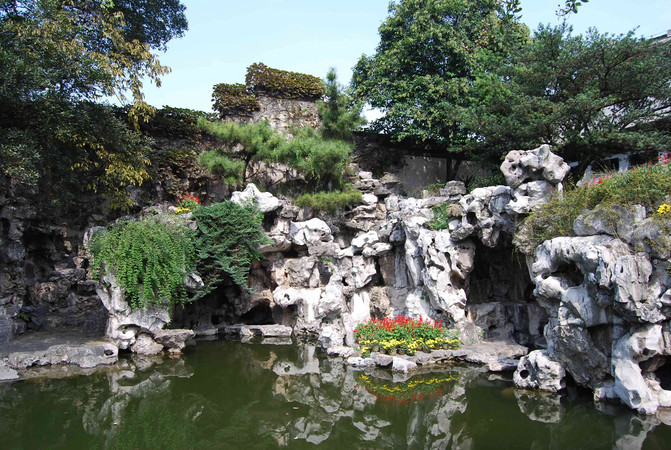
Pianshi Mountain House
Also known as Shuanghuai Garden, the garden is famous for its lake stones and is a rare masterpiece in the art world of the late Ming and early Qing dynasties, where the master Shi Tao stacked stones. Shi Tao, formerly known as Zhu Ruoji, was an outstanding painter in China during the late Ming and early Qing dynasties. He spent his entire life painting famous mountains and rivers, "searching for nearby peaks and sketching". In his later years, he lived in Yangzhou and left behind a rare book of stacked stones.

Water Moon
It is a wonder in the rockery and ravine of the stone mountain house. During the day, there is a bright moon reflected in the pool water, and it varies in brightness with the viewer's perspective. Originally a hole on the wall after stacking stones, it was covered by the stacked stones from different perspectives




Crescent Wall



The family motto of He

Series certificate
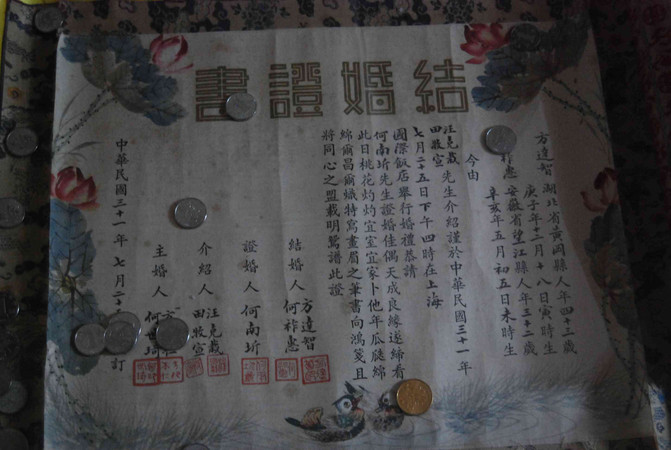



The ancient canal Water sightseeing: The Grand Canal between Beijing and Hangzhou is the longest artificial river in the world, running north-south and serving as a bridge connecting the two thousand years of Chinese civilization. The Yangzhou section of the Grand Canal is the oldest section of the Grand Canal. Walk along the riverbank and reach the end of Dongguan Ancient Street to reach the canal







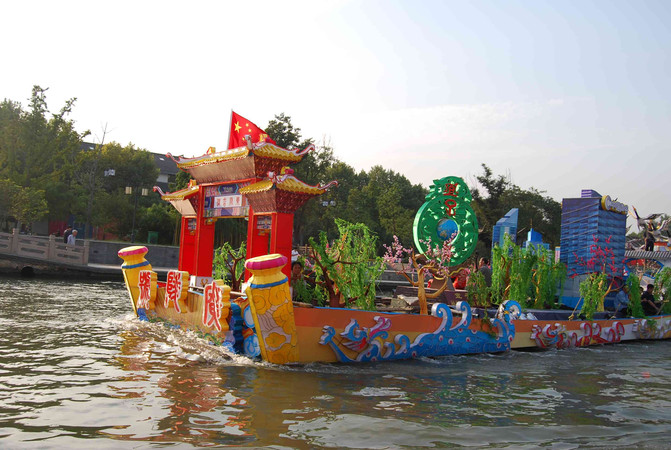




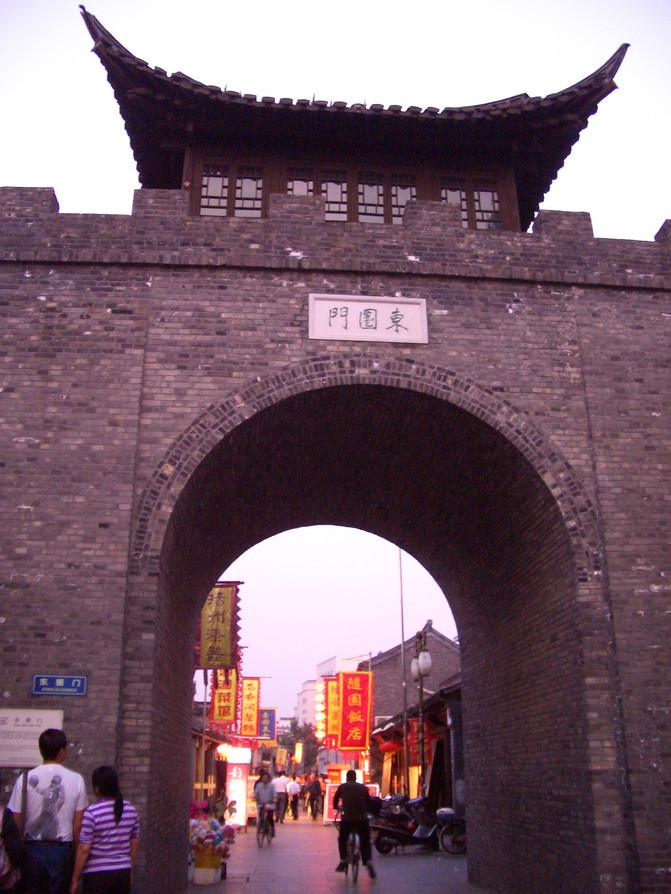

Wenchang Pavilion
Built during the Wanli period of the Ming Dynasty, it was the Kuixing Tower of Yangzhou Prefectural School, hence the name "Wenchang Pavilion"; On festive nights, the colorful lights on the pavilion shine brightly, making it a beautiful scenery in the bustling city of Yangzhou.
·Wenchang Pavilion is an octagonal three-level brick and wood structure building, similar to the Hall of Prayer for Good Harvests at the Temple of Heaven in Beijing; The bottom floor of the pavilion has arches on all sides, connecting to the street. The second, third, and second floors of the pavilion have virtual windows on all sides, offering a panoramic view of the distant and distant street scenes.

Yangzhou Eight Eccentrics Memorial Hall Located southeast of Shouxi Lake, it was transformed from the Western Temple where Jin Nong, one of the Eight Eccentrics of Yangzhou, resided in his later years
The Eight Eccentrics of Yangzhou refer to a group of innovative painters in Yangzhou during the Qing Dynasty, also known as the Yangzhou School of Painting. The specific eight painters referred to by the Eight Eccentrics have different opinions in the history of Chinese painting, but are generally recognized as Jin Nong, Zheng Xie, Huang Shen, Li Jiao, Li Fangying, Wang Shishen, Luo Pin, Gao Xiang, and others

The the Shakya ManiHall is now the main exhibition hall of the Memorial Hall. Remember to look up. Most of the beautiful colored paintings on the beams are from the Ming Dynasty. In the center of the hall stands the statue of the Eight Eccentrics of Yangzhou, surrounded by exhibitions, but most of the paintings and calligraphy are imitations.

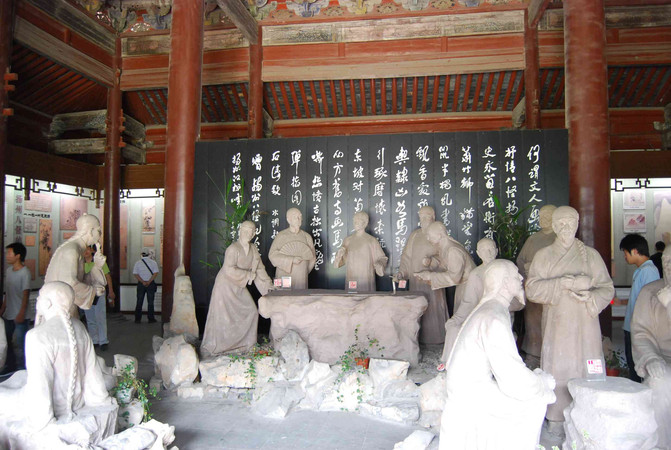


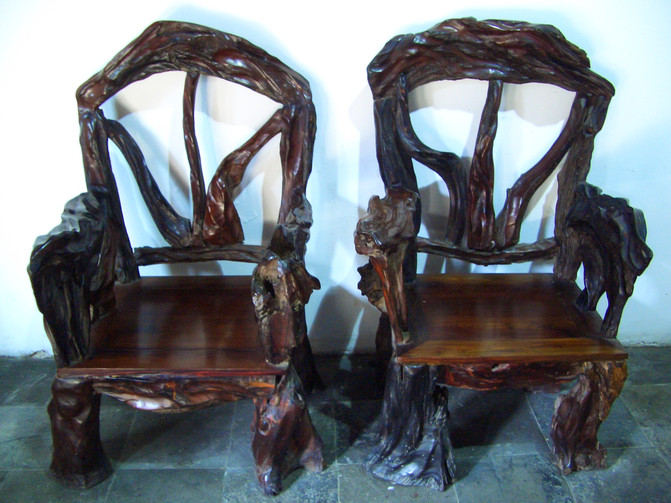


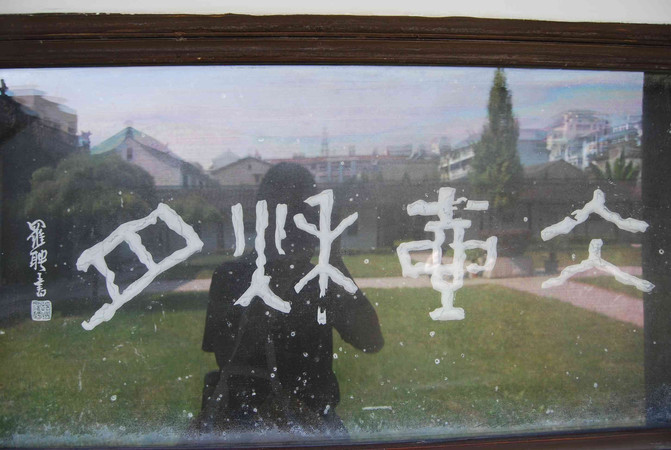

Yangzhou Dual Museum Including Yangzhou Museum and China Woodblock Printing Museum. The architectural appearance fully embodies the design concept of harmonious unity between humans and nature, and the integration of architecture and nature.
The first floor of Yangzhou Museum is a temporary exhibition hall. The second floor is the National Treasure Museum, Sculpture Art Museum, and Calligraphy and Painting Museum.

The entire exhibition hall of the National Treasure Museum only displays one cultural relic - the "Treasure of the Town Hall": Yuanji Blue Glazed White Dragon Pattern Plum Vase Measuring 43.5 centimeters in height, 5.5 centimeters in diameter, with a maximum abdominal diameter of 25.3 centimeters and a base diameter of 14 centimeters, it is the largest, best shaped, and most well preserved of the three Yuan Dynasty blue glazed white dragon patterned plum vases in existence. The other two are respectively collected in the Summer Palace in Beijing and the Jimei Museum in Paris.


Summary :
During this long pandemic holiday, I particularly enjoyed a peaceful life at home, sleeping until I woke up naturally, planting flowers and causing trouble, drinking tea and reading books, watching movies, listening to speeches and music, chatting with friends about life and learning when bored - I am also busy every day, relaxed and at ease! Perhaps life requires finding passion from past experiences, so organize the footprints you have walked in the past to review, summarize, and reflect - in fact, every step in the past has become your present self!
I am particularly emotional in life. When I chose a destination city, there were some spiritual lights that appeared. Then came a spontaneous trip, and organizing photos was also a challenge. Estonia has never had a suitable time or mood to look back on this period. Looking back at myself after the COVID-19 pandemic in the 17th century, it seems like time has flowed back. I sold my house in SAS and planned to go abroad. I did what I wanted to do, actively, boldly and fearlessly - to experience the beauty of life to the fullest. Now it seems that I am ignorant and inactive. But now, I have lost my passion for life and can no longer find the courage to sell my house to do what I long for. Instead, I live a simple and ordinary Buddhist life! Before, when I was in the countryside, I wanted to go to the city, when I was in the city, I wanted to go abroad, and when I was abroad, I wanted to return to my home country. Now, when I am in the city, I want to go back to the countryside. It really fulfills the saying 'may you run away for half your life and return as a young man'. I have been living in the city for too long and feel restless, so I went back to my hometown before Qingming Festival. I also encountered heavy snowfall in March and stayed for a rare week, which was particularly relaxing and comfortable. In fact, deep down, I still live in the peaceful and idyllic countryside life of my childhood! Just like the trip to Yangzhou that year, it was warm, romantic, and enjoyable-------
I went to the woods, Thoreau
I went to the woods because I want to live deliberately
I went to live deep and suck out all the marrow of life
to put to rout all that was not life --and not ,
when I came to die,discover that I had not lived
